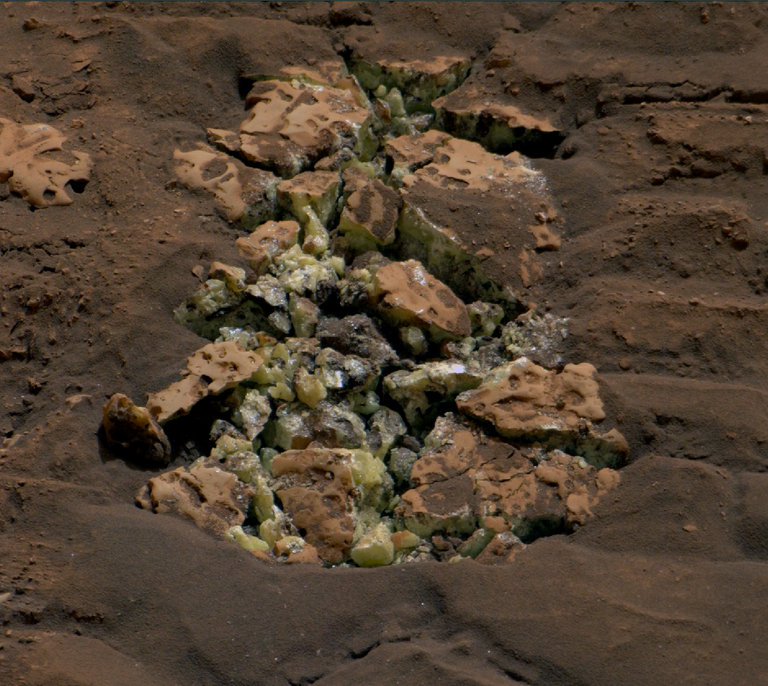Green Rocks on Mars.
Green Rocks on Mars.
The Robert Curiosity is enormous, it weighs almost 900 kg on Earth and about 333 kg on Mars, in size it only surpasses it and just barely the opportunity, so wherever it steps this Rover leaves its mark, it is capable of lifting surface dust, revealing light. what is underneath and is also capable of breaking rocks when it passes with its wheels as long as these rocks are not very hard.
Since October 2023, the rover has been exploring a region of Mars in sulfates, the Gediz Valley, this Valley is a groove that winds through part of Mount Sharp, a mountain 5 km high, there in that Valley there is a type of salt which contains sulfur and is formed as water evaporates, something we would find at the bottom of a large dry lake or the bottom of a Dead Sea, but while previous finds have been of sulfur-based minerals, in others mineral words that are a mixture of sulfur with other materials, the Rock that is in the news now is made of elemental sulfur or pure sulfur, and this is very rare.
From NASA, curiosity project scientist Ashwin Vasavada said “finding a field of stones made of pure sulfur is like finding an oasis in the desert.” The researcher said it is not clear what relationship, if any, this sulfur has. Pure this elemental sulfur with other sulfur-based minerals in the area.
Although people associate sulfur with the smell of rotten eggs, the result of hydrogen sulfur gas, elemental sulfur and pure sulfur, it is very different; it has no smell and is also formed in very very extreme conditions, the amazing thing is that sulfur Curiosity has found much of this pure element, here on earth curiosity would be considered to have found a sulfur mine of extraordinary quality.
The mission of the Curious is not to find Mines, but it is not bad that it finds one of minerals of this type, perhaps this discovery will be valuable in the future, the Mission of the Curious is to study where and when the ancient terrain of the red planet could have provided the nutrients necessary for microbial life, if it ever formed on Mars and this finding may be an important clue, keep in mind that the Gediz Valley channel is one of the main reasons why the scientific team wanted to visit that part from Mars.
Scientists believe the canal was carved by flows of liquid water and debris that left a ridge of rock and sediment that extends about 3 km down the mountainside below the Canal. The goal of the mission is to understand what that canal was like. place thousands of millions of years ago when water was abundant and flowed through the valley.
Can you imagine a Martian landscape of rivers and ice, it would be similar to what we find today in the north of Canada or in the coastal torrents of Greenland because yes, Mars had water, but it was also a cold place, it was a time when that Mars was not the red planet but a blue and white world, and although it had a much denser atmosphere than the current one with a density close to that of the Earth's atmosphere, Mars was cold and not only because it is located further away of the sun than the earth, also because in the first billion years of the sun's existence, it was less bright and colder than today.
Thank you for visiting my blog. If you like posts about #science, #planet, #politics, #rights #crypto, #traveling and discovering secrets and beauties of the #universe, feel free to Follow me as these are the topics I write about the most. Have a wonderful day and stay on this great platform :) :)
! The truth will set us free and science is the one that is closest to the truth!
0
0
0.000

Thanks for your contribution to the STEMsocial community. Feel free to join us on discord to get to know the rest of us!
Please consider delegating to the @stemsocial account (85% of the curation rewards are returned).
You may also include @stemsocial as a beneficiary of the rewards of this post to get a stronger support.